Scaling-Up of Solution-Processable Tungsten Trioxide (WO3) Nanoparticles as a Hole Transport Layer in Inverted Organic Photovoltaics
Abstract
:1. Introduction
2. Materials and Methods
2.1. Materials
2.2. Device Fabrication
2.2.1. HTL Solar PEDOT:PSS Deposition
2.2.2. HTL WO3 Deposition
2.3. Characterization
3. Results and Discussions
3.1. Pure WO3 Films: Structural and Morphological Characterization
3.2. WO3 as the HTL in Inverted OPVs via Spin Coating
3.3. WO3 as a HTL in Inverted OPVs via Slot Die and Spray Coating
3.4. Technology Comparison
3.4.1. Analysis of IPCE, Absorbance Spectra and Thickness of Active Layer
3.4.2. Role of Annealing Temperature in Slot-Die- and Spray-Coated WO3
3.5. Stability
4. Conclusions
Supplementary Materials
Author Contributions
Funding
Data Availability Statement
Acknowledgments
Conflicts of Interest
References
- International Renewable Energy Agency (IRENA) Headquarters. Future of Solar Photovoltaic; International Renewable Energy Agency: Abu Dhabi, United Arab Emirates, 2019. [Google Scholar]
- Zhang, H.; Yu, Z.; Zhu, C.; Yang, R.; Yan, B.; Jiang, G. Green or not? Environmental challenges from photovoltaic technology. Environ. Pollut. 2023, 320, 121066. [Google Scholar] [CrossRef]
- Fukuda, K.; Yu, K.; Someya, T. The future of flexible organic solar cells. Adv. Energy Mater. 2020, 10, 2000765. [Google Scholar] [CrossRef]
- Giannouli, M. Current status of emerging PV technologies: A comparative study of dye-sensitized, organic, and perovskite solar cells. Int. J. Photoenergy 2021, 2021, 6692858. [Google Scholar] [CrossRef]
- Chen, B.; Yang, Z.; Jia, Q.; Ball, R.J.; Zhu, Y.; Xia, Y. Emerging applications of metal-organic frameworks and derivatives in solar cells: Recent advances and challenges. Mater. Sci. Eng. R Rep. 2023, 152, 100714. [Google Scholar] [CrossRef]
- La Notte, L.; Cataldi, P.; Ceseracciu, L.; Bayer, I.S.; Athanassiou, A.; Marras, S.; Villari, E.; Brunetti, F.; Reale, A. Fully-sprayed flexible polymer solar cells with a cellulose-graphene electrode. Mater. Today Energy 2018, 7, 105–112. [Google Scholar] [CrossRef]
- Solak, E.K.; Irmak, E. Advances in organic photovoltaic cells: A comprehensive review of materials, technologies, and performance. RSC Adv. 2023, 13, 12244–12269. [Google Scholar] [CrossRef] [PubMed]
- Ren, M.; Qian, X.; Chen, Y.; Wang, T.; Zhao, Y. Potential lead toxicity and leakage issues on lead halide perovskite photovoltaics. J. Hazard. Mater. 2022, 426, 127848. [Google Scholar] [CrossRef]
- Nguyen, V.H.; Papanastasiou, D.T.; Resende, J.; Bardet, L.; Sannicolo, T.; Jiménez, C.; Muñoz-Rojas, D.; Nguyen, N.D.; Bellet, D. Advances in flexible metallic transparent electrodes. Small 2022, 18, 2106006. [Google Scholar] [CrossRef]
- Salim, M.B.; Nekovei, R.; Jeyakumar, R. Organic tandem solar cells with 18.6% efficiency. Solar Energy 2020, 198, 160–166. [Google Scholar] [CrossRef]
- Wang, D.; Liu, H.; Li, Y.; Zhou, G.; Zhan, L.; Zhu, H.; Lu, X.; Chen, H.; Li, C.-Z. High-performance and eco-friendly semitransparent organic solar cells for greenhouse applications. Joule 2021, 5, 945–957. [Google Scholar] [CrossRef]
- Hoff, A.; Farahat, M.E.; Pahlevani, M.; Welch, G.C. Tin oxide electron transport layers for air-/solution-processed conventional organic solar cells. ACS Appl. Mater. Interfaces 2022, 14, 1568–1577. [Google Scholar] [CrossRef]
- Zheng, Z.; Wang, J.; Bi, P.; Ren, J.; Wang, Y.; Yang, Y.; Liu, X.; Zhang, S.; Hou, J. Tandem organic solar cell with 20.2% efficiency. Joule 2022, 6, 171–184. [Google Scholar] [CrossRef]
- NREL Efficiency Chart. 2023. Available online: https://www.nrel.gov/pv/cell-efficiency.html (accessed on 11 January 2024).
- Reb, L.K.; Böhmer, M.; Predeschly, B.; Grott, S.; Weindl, C.L.; Ivandekic, G.I.; Guo, R.; Dreißigacker, C.; Gernhäuser, R.; Meyer, A.; et al. Perovskite and organic solar cells on a rocket flight. Joule 2020, 4, 1880–1892. [Google Scholar] [CrossRef]
- Tu, Y.; Wu, J.; Xu, G.; Yang, X.; Cai, R.; Gong, Q.; Zhu, R.; Huang, W. Perovskite solar cells for space applications: Progress and challenges. Adv. Mater. 2021, 33, 2006545. [Google Scholar] [CrossRef] [PubMed]
- Güler, E.N.; Distler, A.; Basu, R.; Brabec, C.J.; Egelhaaf, H.-J. Fully solution-processed, light-weight, and ultraflexible organic solar cells. Flex. Print. Electron. 2022, 7, 025003. [Google Scholar] [CrossRef]
- Lee, C.; Lee, J.; Lee, S.; Lee, W.; You, H.; Woo, H.Y.; Kim, B.J. Importance of device structure and interlayer design in storage stability of naphthalene diimide-based all-polymer solar cells. J. Mater. Chem. A 2020, 8, 3735–3745. [Google Scholar] [CrossRef]
- Wang, D.; Zhou, G.; Li, Y.; Yan, K.; Zhan, L.; Zhu, H.; Lu, X.; Chen, H.; Li, C.Z. High-Performance Organic Solar Cells from Non-Halogenated Solvents. Adv. Funct. Mater. 2022, 32, 2107827. [Google Scholar] [CrossRef]
- Fan, J.Y.; Liu, Z.X.; Rao, J.; Yan, K.; Chen, Z.; Ran, Y.; Yan, B.; Yao, J.; Lu, G.; Zhu, H. High-Performance Organic Solar Modules via Bilayer-Merged-Annealing Assisted Blade Coating. Adv. Mater. 2022, 34, 2110569. [Google Scholar] [CrossRef]
- Sreejith, S.; Sivasankari, B. A review on P3HT: PCBM material based organic solar cells. In Proceedings of the 2022 IEEE International Conference on Nanoelectronics, Nanophotonics, Nanomaterials, Nanobioscience & Nanotechnology (5NANO), Kottayam, India, 27 April–3 May 2022; pp. 1–6. [Google Scholar] [CrossRef]
- Li, Y.; Huang, X.; Sheriff, H.K., Jr.; Forrest, S.R. Semitransparent organic photovoltaics for building-integrated photovoltaic applications. Nat. Rev. Mater. 2023, 8, 186–201. [Google Scholar] [CrossRef]
- Duan, L.; Hoex, B.; Uddin, A. Progress in semitransparent organic solar cells. Solar RRL 2021, 5, 2100041. [Google Scholar] [CrossRef]
- Allardyce, C.S.; Fankhauser, C.; Zakeeruddin, S.M.; Grätzel, M.; Dyson, P.J. The influence of greenhouse-integrated photovoltaics on crop production. Solar Energy 2017, 155, 517–522. [Google Scholar] [CrossRef]
- La Notte, L.; Giordano, L.; Calabrò, E.; Bedini, R.; Colla, G.; Puglisi, G.; Reale, A. Hybrid and organic photovoltaics for greenhouse applications. Appl. Energy 2020, 278, 115582. [Google Scholar] [CrossRef]
- Cui, Y.; Hong, L.; Hou, J. Organic photovoltaic cells for indoor applications: Opportunities and challenges. ACS Appl. Mater. Interfaces 2020, 12, 38815–38828. [Google Scholar] [CrossRef] [PubMed]
- Lee, D.; Kim, J.; Park, G.; Bae, H.W.; An, M.; Kim, J.Y. Enhanced operating temperature stability of organic solar cells with metal oxide hole extraction layer. Polymers 2020, 12, 992. [Google Scholar] [CrossRef] [PubMed]
- Yeom, H.R.; Heo, J.; Kim, G.-H.; Ko, S.-J.; Song, S.; Jo, Y.; Kim, D.S.; Walker, B.; Kim, J.Y. Optimal top electrodes for inverted polymer solar cells. Phys. Chem. Chem. Phys. 2015, 17, 2152–2159. [Google Scholar] [CrossRef]
- Shen, J.-J. Recently-explored top electrode materials for transparent organic solar cells. Synth. Met. 2021, 271, 116582. [Google Scholar] [CrossRef]
- Alkarsifi, R.; Ackermann, J.; Margeat, O. Hole transport layers in organic solar cells: A review. J. Met. Mater. Miner. 2022, 32, 1–22. [Google Scholar] [CrossRef]
- You, H.; Dai, L.; Zhang, Q.; Chen, D.; Jiang, Q.; Zhang, C. Enhanced performance of inverted non-fullerene organic solar cells by using metal oxide electron-and hole-selective layers with process temperature ≤ 150 °C. Polymers 2018, 10, 725. [Google Scholar] [CrossRef]
- Vaishnav, M.; Sarang, P.; Harikrishnan, V.; Gopinadh, A.; Jayaraj, S.; Predeep, P. Inverting the organic solar cell. In IOP Conference Series: Materials Science and Engineering; IOP Publishing: Bristol, UK, 2020; Volume 872, p. 012007. [Google Scholar]
- Li, N.; Stubhan, T.; Luechinger, N.A.; Halim, S.C.; Matt, G.J.; Ameri, T.; Brabec, C.J. Inverted structure organic photovoltaic devices employing a low temperature solution processed WO3 anode buffer layer. Org. Electron. 2012, 13, 2479–2484. [Google Scholar] [CrossRef]
- Remya, R.; Gayathri, P.; Deb, B. Studies on solution-processed tungsten oxide nanostructures for efficient hole transport in the inverted polymer solar cells. Mater. Chem. Phys. 2020, 255, 123584. [Google Scholar] [CrossRef]
- Zilberberg, K.; Trost, S.; Meyer, J.; Kahn, A.; Behrendt, A.; Lützenkirchen-Hecht, D.; Frahm, R.; Riedl, T. Inverted Organic Solar Cells with Sol–Gel Processed High Work-Function Vanadium Oxide Hole-Extraction Layers. Adv. Funct. Mater. 2011, 21, 4776–4783. [Google Scholar] [CrossRef]
- Çetinkaya, Ç.; Çokduygulular, E.; Kınacı, B.; Güzelçimen, F.; Candan, I.; Efkere, H.İ.; Özen, Y.; Özçelik, S. Evaluation on output parameters of the inverted organic solar cells depending on transition-metal-oxide based hole-transporting materials. Opt. Mater. 2021, 120, 111457. [Google Scholar] [CrossRef]
- Park, S.; Wibowo, F.T.A.; Krishna, N.V.; Ryu, J.; Lee, H.; Lee, J.H.; Yoon, Y.J.; Kim, J.Y.; Seo, J.H.; Oh, S.-H. Importance of interface engineering between the hole transport layer and the indium-tin-oxide electrode for highly efficient polymer solar cells. J. Mater. Chem. A 2021, 9, 15394–15403. [Google Scholar] [CrossRef]
- Chen, H.; Yin, Z.; Ma, Y.; Cai, D.; Zheng, Q. Solution-processed polymer bilayer heterostructures as hole-transport layers for high-performance opaque and semitransparent organic solar cells. Mater. Today Energy 2023, 35, 101322. [Google Scholar] [CrossRef]
- Falco, A.; Zaidi, A.; Lugli, P.; Abdellah, A. Spray deposition of Polyethylenimine thin films for the fabrication of fully-sprayed organic photodiodes. Org. Electron. 2015, 23, 186–192. [Google Scholar] [CrossRef]
- Zhao, W.; Qian, D.; Zhang, S.; Li, S.; Inganäs, O.; Gao, F.; Hou, J. Fullerene-free polymer solar cells with over 11% efficiency and excellent thermal stability. Adv. Mater. 2016, 28, 4734–4739. [Google Scholar] [CrossRef] [PubMed]
- Bin, H.; Zhang, Z.-G.; Gao, L.; Chen, S.; Zhong, L.; Xue, L.; Yang, C.; Li, Y. Non-fullerene polymer solar cells based on alkylthio and fluorine substituted 2D-conjugated polymers reach 9.5% efficiency. J. Am. Chem. Soc. 2016, 138, 4657–4664. [Google Scholar] [CrossRef] [PubMed]
- Anefnaf, I.; Aazou, S.; Schmerber, G.; Dinia, A.; Sekkat, Z. Tailoring PEIE capped ZnO binary cathode for solution-processed inverted organic solar cells. Opt. Mater. 2021, 116, 111070. [Google Scholar] [CrossRef]
- Reale, A.; La Notte, L.; Salamandra, L.; Polino, G.; Susanna, G.; Brown, T.M.; Brunetti, F.; Di Carlo, A. Spray Coating for Polymer Solar Cells: An Up-to-Date Overview. Energy Technol. 2015, 3, 385–406. [Google Scholar] [CrossRef]
- La Notte, L.; Polino, G.; Ciceroni, C.; Brunetti, F.; Brown, T.M.; Di Carlo, A.; Reale, A. Spray-Coated Polymer Solar Cells based on Low-Band-Gap Donors Processed with ortho-Xylene. Energy Technol. 2014, 2, 786–791. [Google Scholar] [CrossRef]
- La Notte, L.; Bianco, G.V.; Palma, A.L.; Di Carlo, A.; Bruno, G.; Reale, A. Sprayed organic photovoltaic cells and mini-modules based on chemical vapor deposited graphene as transparent conductive electrode. Carbon 2017, 129, 878–883. [Google Scholar] [CrossRef]
- Park, S.; Kim, T.; Yoon, S.; Koh, C.W.; Woo, H.Y.; Son, H.J. Progress in Materials, Solution Processes, and Long-Term Stability for Large-Area Organic Photovoltaics. Adv. Mater. 2020, 32, 2002217. [Google Scholar] [CrossRef] [PubMed]
- Sampaio, P.G.V.; González, M.O.A.; de Oliveira Ferreira, P.; da Cunha Jacome Vidal, P.; Pereira, J.P.P.; Ferreira, H.R.; Oprime, P.C. Overview of printing and coating techniques in the production of organic photovoltaic cells. Int. J. Energy Res. 2020, 44, 9912–9931. [Google Scholar] [CrossRef]
- Su, J.; Guo, L.; Bao, N.; Grimes, C.A. Nanostructured WO3/BiVO4 heterojunction films for efficient photoelectrochemical water splitting. Nano Lett. 2011, 11, 1928–1933. [Google Scholar] [CrossRef] [PubMed]
- Andrei, F.; Andrei, A.; Birjega, R.; Sirjita, E.N.; Radu, A.I.; Dinescu, M.; Ion, V.; Maraloiu, V.-A.; Teodorescu, V.Ş.; Scarisoreanu, N.D. The Influence of the Structural and Morphological Properties of WO3 Thin Films Obtained by PLD on the Photoelectrochemical Water-Splitting Reaction Efficiency. Nanomaterials 2021, 11, 110. [Google Scholar] [CrossRef] [PubMed]
- Kalanur, S.S.; Hwang, Y.J.; Chae, S.Y.; Joo, O.S. Facile growth of aligned WO3 nanorods on FTO substrate for enhanced photoanodic water oxidation activity. J. Mater. Chem. A 2013, 1, 3479–3488. [Google Scholar] [CrossRef]
- Righettoni, M.; Pratsinis, S.E. Annealing dynamics of WO3 by in situ XRD. Mater. Res. Bull. 2014, 59, 199–204. [Google Scholar] [CrossRef]
- Xia, Z.-J.; Wang, H.-L.; Su, Y.-F.; Tang, P.; Dai, M.-J.; Lin, H.-J.; Zhang, Z.-G.; Shi, Q. Enhanced electrochromic properties by improvement of crystallinity for sputtered WO3 film. Coatings 2020, 10, 577. [Google Scholar] [CrossRef]
- Senthilkumar, R.; Ravi, G.; Sekar, C.; Arivanandhan, M.; Navaneethan, M.; Hayakawa, Y. Determination of gas sensing properties of thermally evaporated WO3 nanostructures. J. Mater. Sci. Mater. Electron. 2015, 26, 1389–1394. [Google Scholar] [CrossRef]
- Shen, Y.; Lou, Y.; Wang, Z.; Xu, X. In-situ growth and characterization of indium tin oxide nanocrystal rods. Coatings 2017, 7, 212. [Google Scholar] [CrossRef]
- Qiao, F.; Lu, L.; Han, P.; Ge, D.; Rui, Y.; Gu, D.; Zhang, T.; Hou, J.; Yang, Y. A combined experimental and theoretical Study of Screen-printing High transparent conductive Mesoscopic ito films. Sci. Rep. 2020, 10, 5024. [Google Scholar] [CrossRef] [PubMed]
- Garcia-Sanchez, R.F.; Ahmido, T.; Casimir, D.; Baliga, S.; Misra, P. Thermal effects associated with the Raman spectroscopy of WO3 gas-sensor materials. J. Phys. Chem. A 2013, 117, 13825–13831. [Google Scholar] [CrossRef]
- Guillén, C. Physical Properties of SnO2/WO3 Bilayers Prepared by Reactive DC Sputtering. Adv. Energy Convers. Mater. 2023, 4, 29–37. [Google Scholar] [CrossRef]
- Niazi, M.R.; Munir, R.; D’Souza, R.M.; Kelly, T.L.; Welch, G.C. Scalable Non-Halogenated Co-solvent System for Large-Area, Four-Layer Slot-Die-Coated Organic Photovoltaics. ACS Appl. Mater. Interfaces 2022, 14, 57055–57063. [Google Scholar] [CrossRef] [PubMed]
- Alexander, A.; Pillai, A.B.; Pulikodan, V.K.; Joseph, A.; Raees, A.M.; Namboothiry, M.A. Hydrophobic poly-TPD modified PEDOT PSS surface for improved and stable photovoltaic performance of MAPbI3 based pin perovskite solar cells. J. Appl. Phys. 2023, 134, 085002. [Google Scholar] [CrossRef]
- Wang, L.-M.; Li, Q.; Liu, S.; Cao, Z.; Cai, Y.-P.; Jiao, X.; Lai, H.; Xie, W.; Zhan, X.; Zhu, T. Quantitative determination of the vertical segregation and molecular ordering of PBDB-T/ITIC blend films with solvent additives. ACS Appl. Mater. Interfaces 2020, 12, 24165–24173. [Google Scholar] [CrossRef]
- Otieno, F.; Kotane, L.; Airo, M.; Erasmus, R.M.; Billing, C.; Wamwangi, D.; Billing, D.G. Comparative investigation of fullerene PC71BM and non-fullerene ITIC-Th acceptors blended with P3HT or PBDB-T donor polymers for PV applications. Front. Energy Res. 2021, 9, 640664. [Google Scholar] [CrossRef]
- Camaioni, N.; Carbonera, C.; Ciammaruchi, L.; Corso, G.; Mwaura, J.; Po, R.; Tinti, F. Polymer Solar Cells with Active Layer Thickness Compatible with Scalable Fabrication Processes: A Meta-Analysis. Adv. Mater. 2023, 35, 2210146. [Google Scholar] [CrossRef]
- Sun, K.; Xiao, Z.; Lu, S.; Zajaczkowski, W.; Pisula, W.; Hanssen, E.; White, J.M.; Williamson, R.M.; Subbiah, J.; Ouyang, J. A molecular nematic liquid crystalline material for high-performance organic photovoltaics. Nat. Commun. 2015, 6, 6013. [Google Scholar] [CrossRef]
- Jeon, K.; Youn, H.; Kim, S.; Shin, S.; Yang, M. Fabrication and characterization of WO3/Ag/WO3 multilayer transparent anode with solution-processed WO3 for polymer light-emitting diodes. Nanoscale Res. Lett. 2012, 7, 253. [Google Scholar] [CrossRef]
- Zou, Y.; Zhang, Y.; Lou, D.; Wang, H.; Gu, L.; Dong, Y.; Dou, K.; Song, X.; Zeng, H. Structural and optical properties of WO3 films deposited by pulsed laser deposition. J. Alloys Compd. 2014, 583, 465–470. [Google Scholar] [CrossRef]
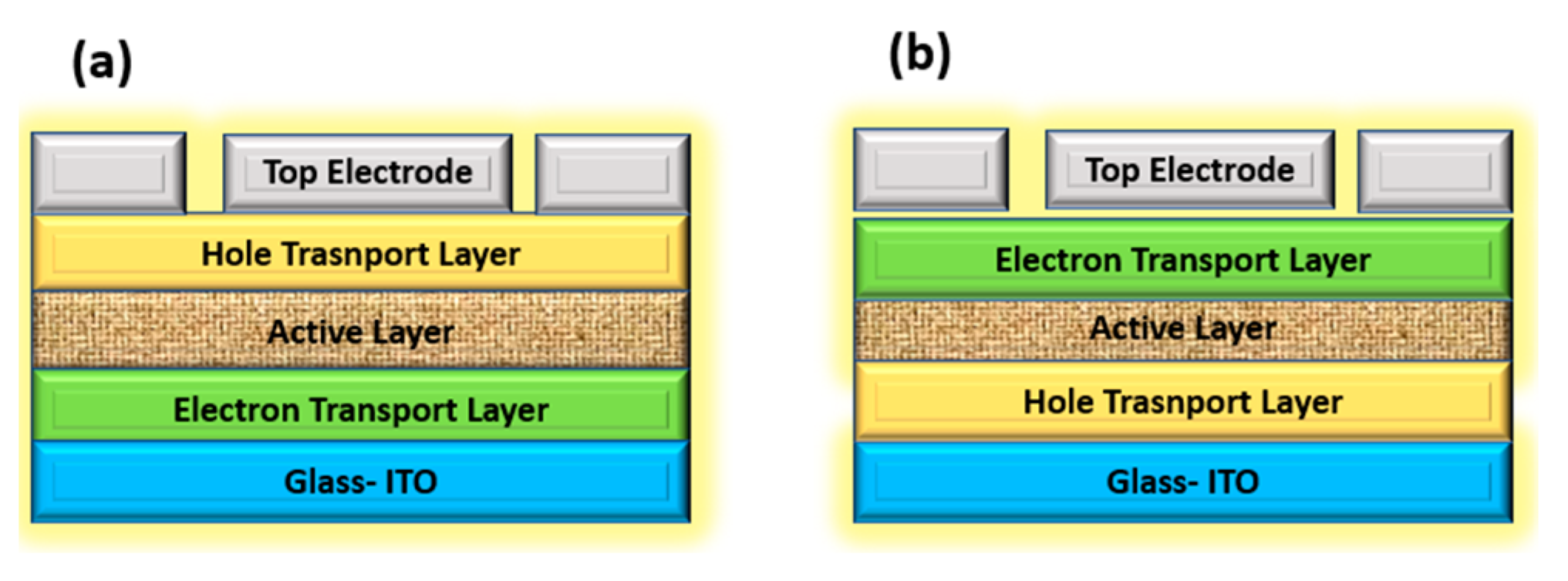
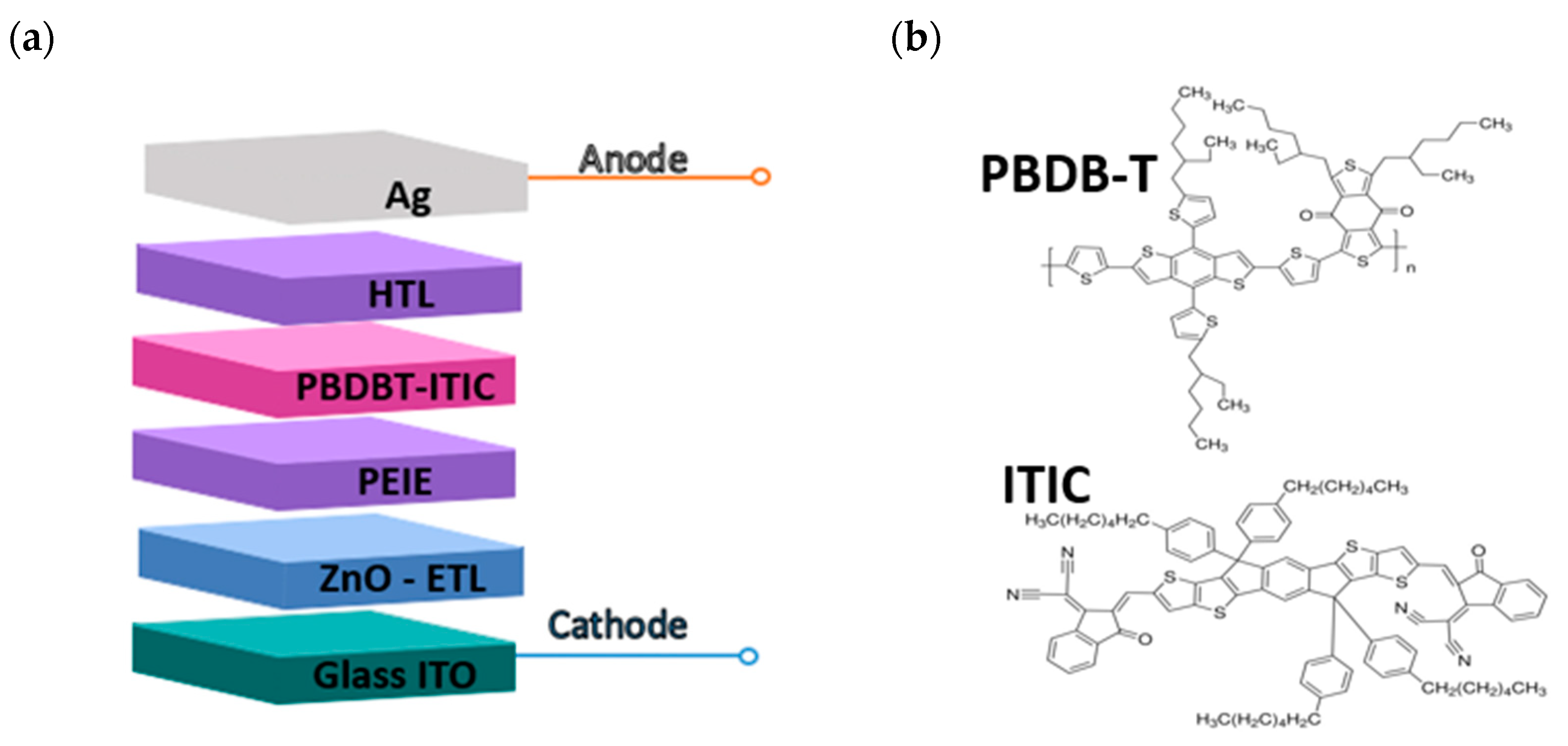
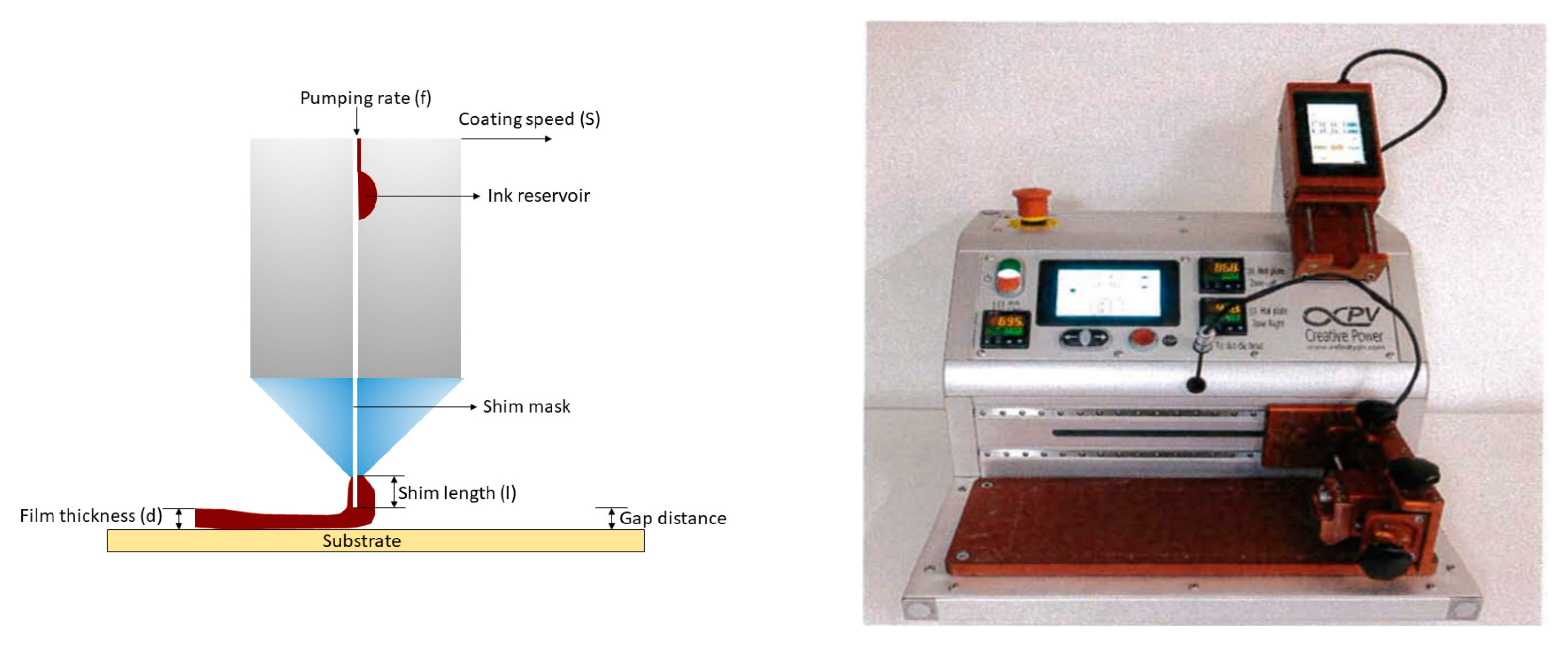

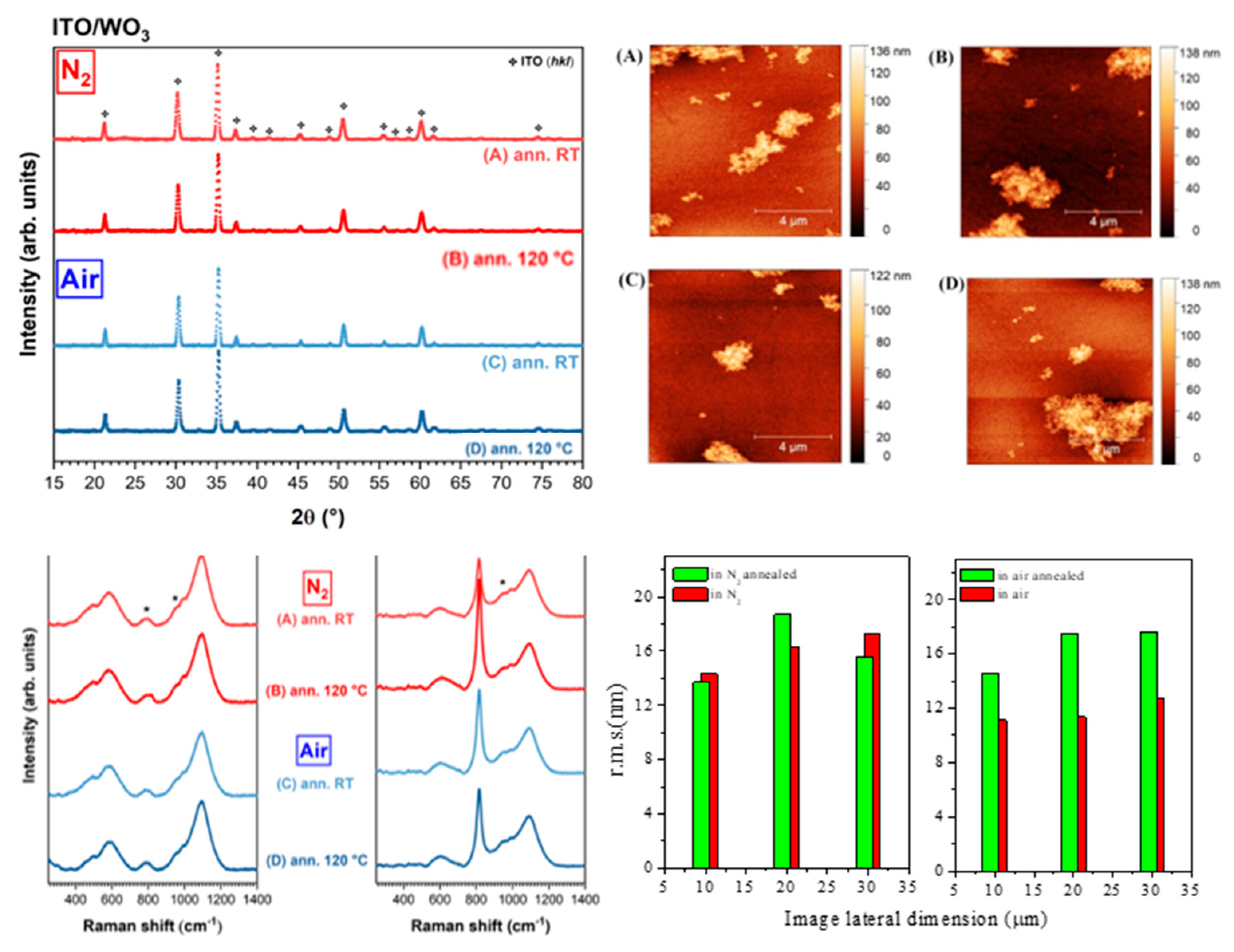
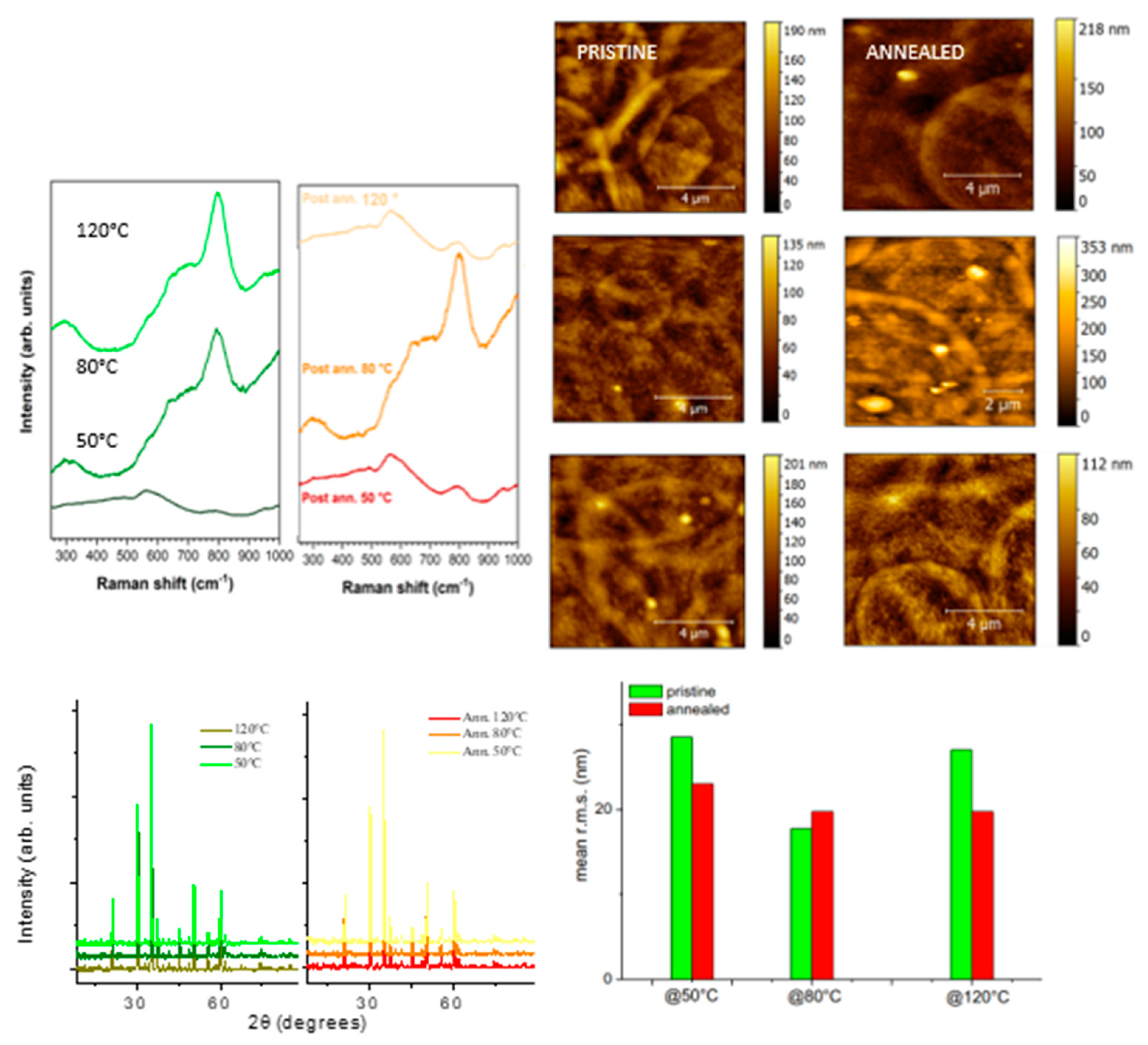
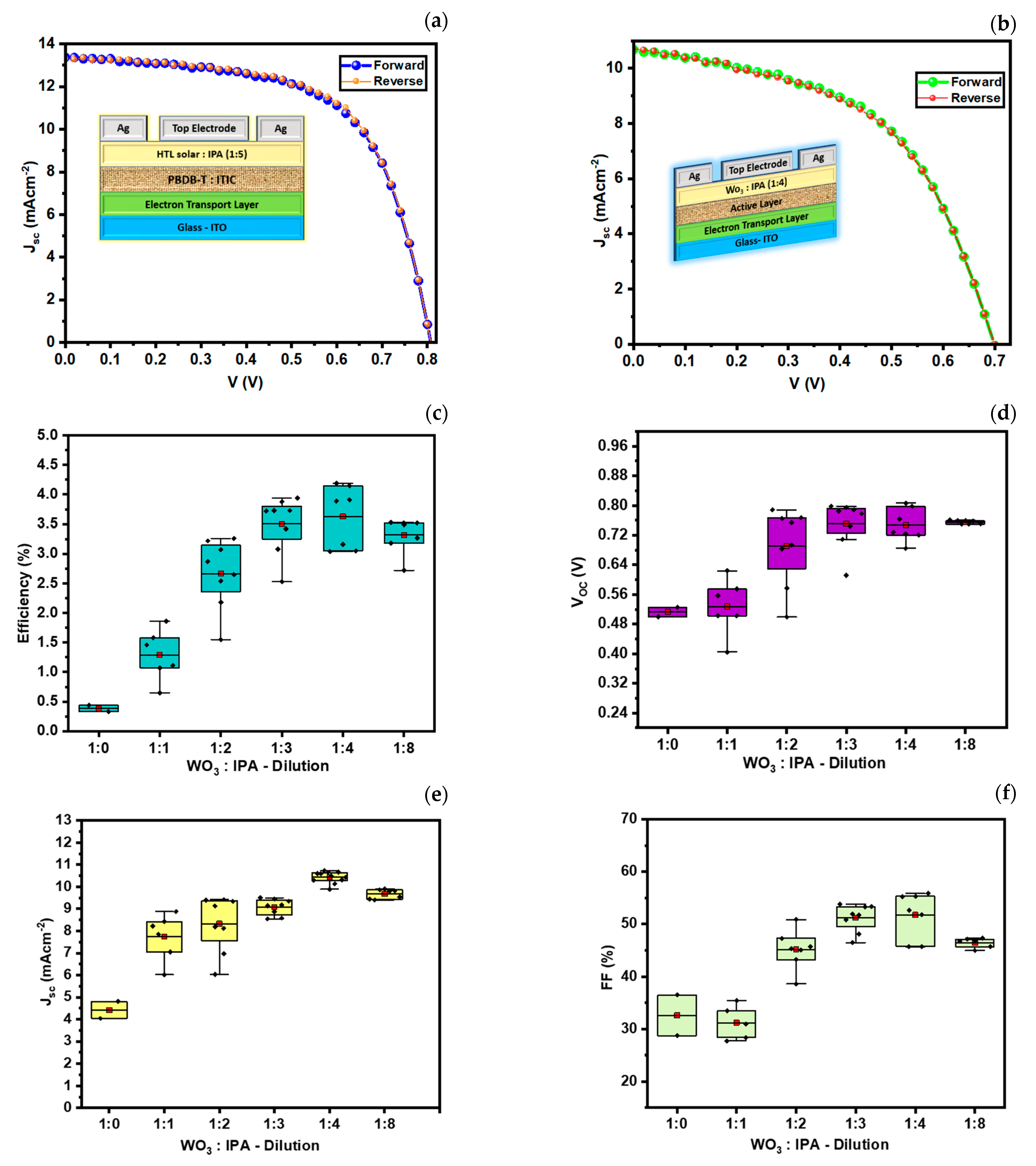

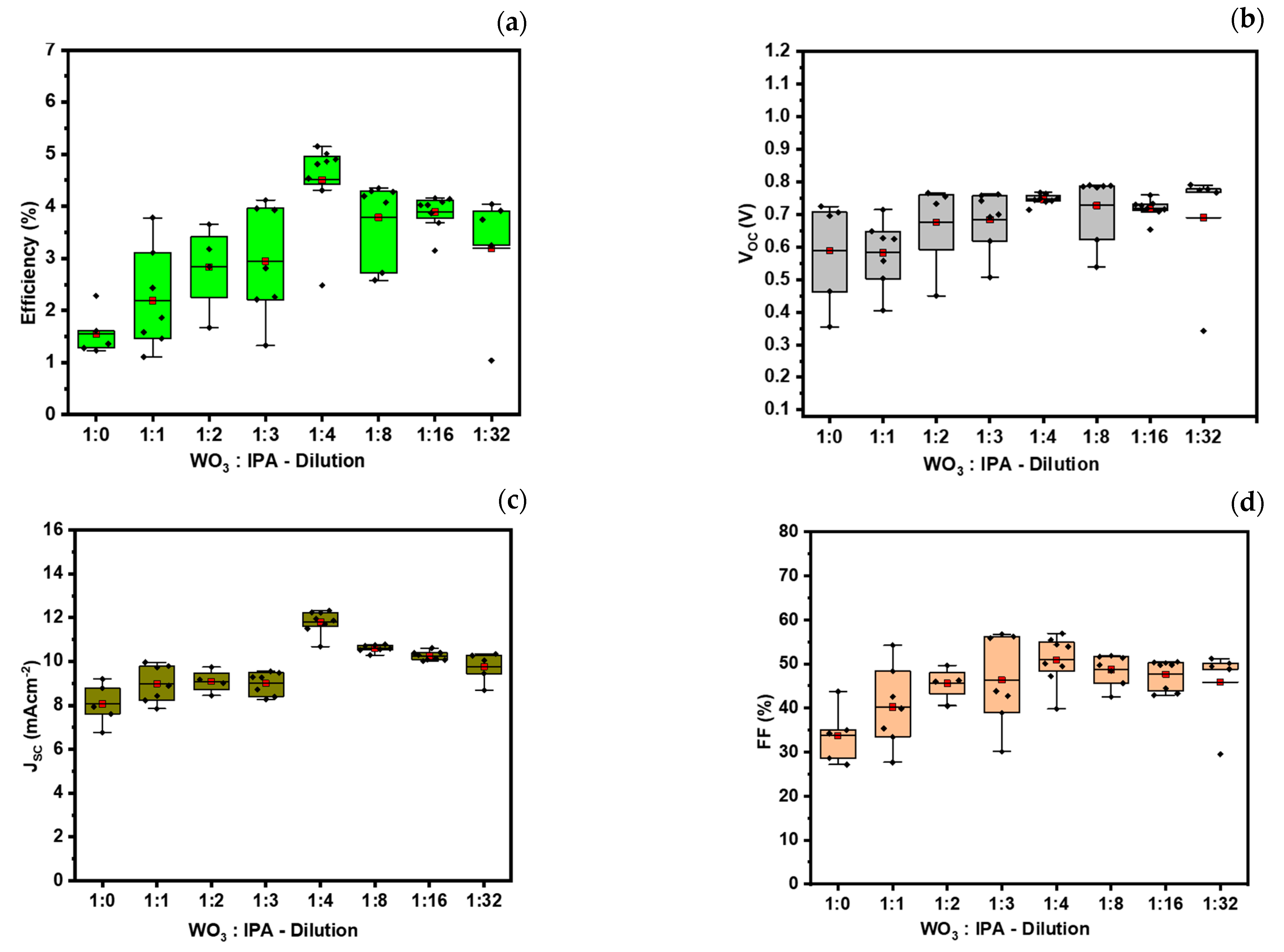
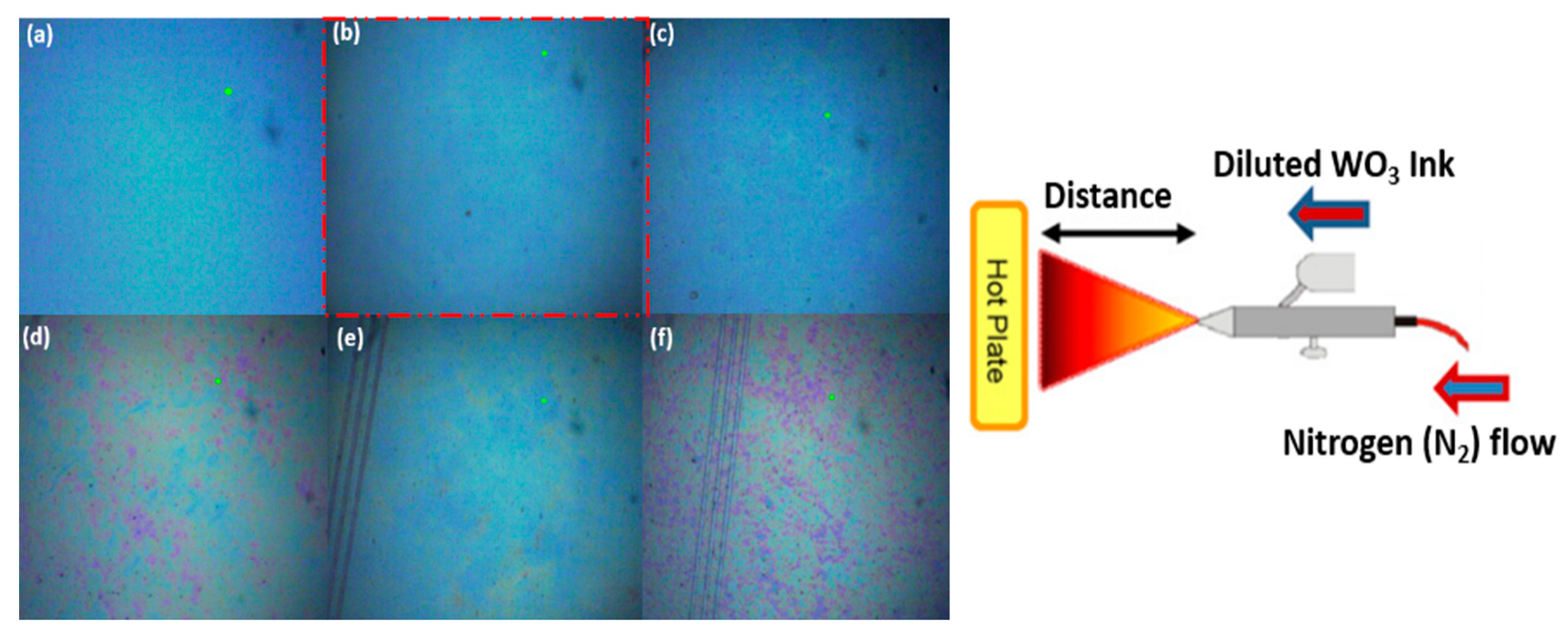
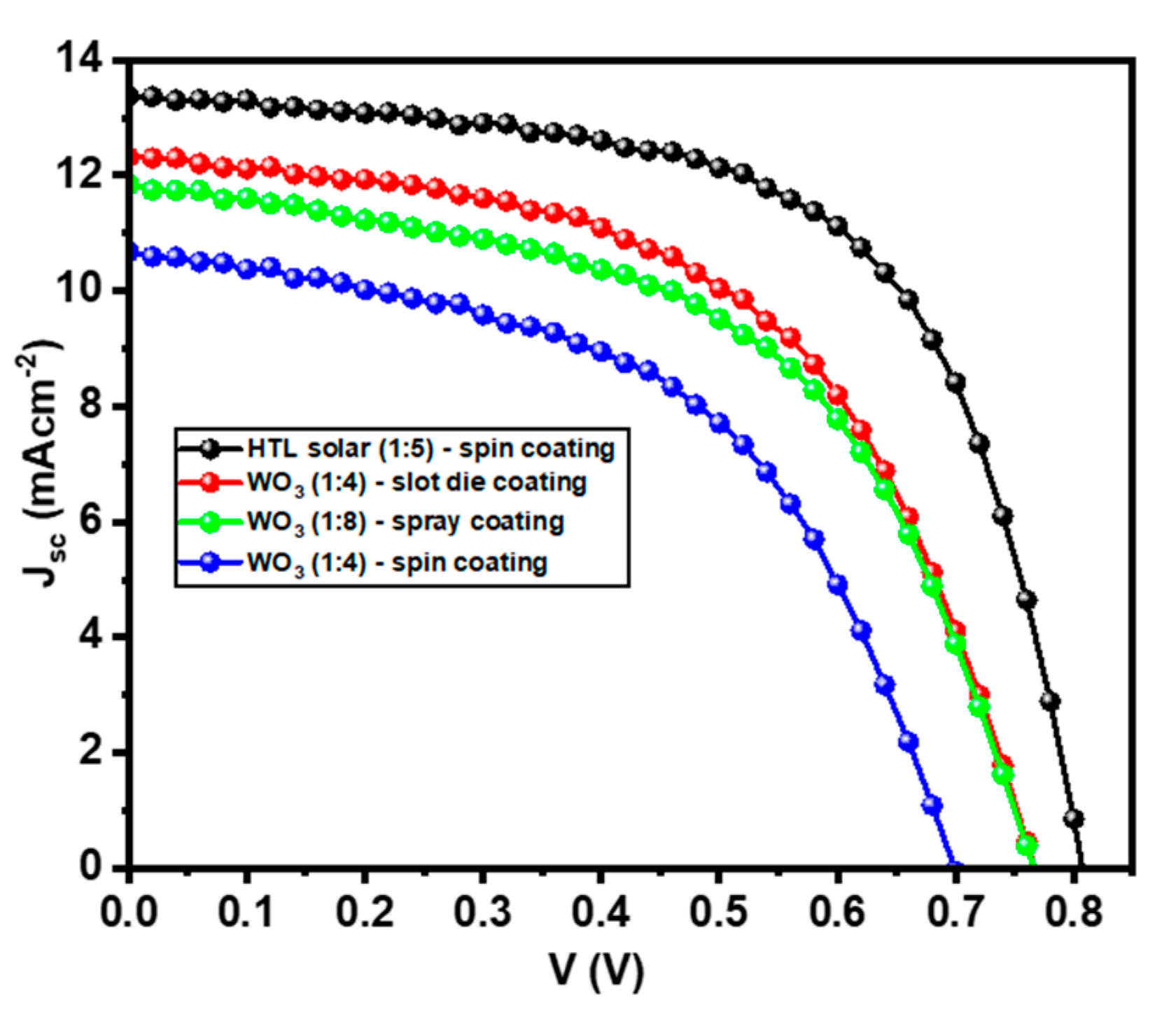


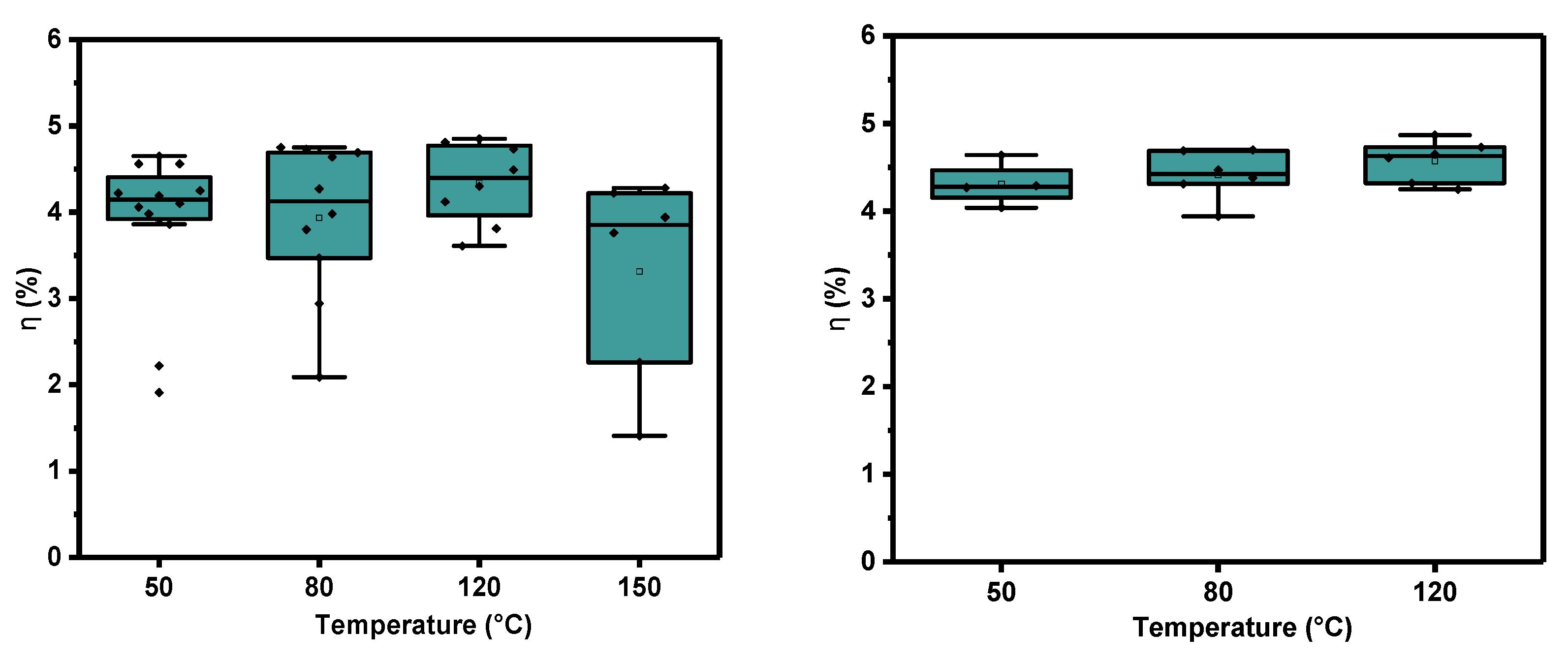


| Device Architecture: | VOC (mV) | JSC (mA/cm2) | FF (%) | Eff. (%) |
|---|---|---|---|---|
| ITO/ZnO/PEIE/PBDB-T:ITIC/HTL solar (1:5) | 0.81 ± 0.018 | 11.83 ± 1.43 | 59.75 ± 1.50 | 5.53 ± 1.03 |
| ITO/ZnO/PEIE/PBDB-T:ITIC/WO3 (1:0) | 0.512 ± 0.017 | 4.42 ± 0.54 | 32.60 ± 5.50 | 0.39 ± 0.07 |
| ITO/ZnO/PEIE/PBDB-T:ITIC/WO3 (1:1) | 0.527 ± 0.075 | 7.74 ± 1.04 | 33.05 ± 5.50 | 1.28 ± 0.43 |
| ITO/ZnO/PEIE/PBDB-T:ITIC/WO3 (1:2) | 0.690 ± 0.103 | 8.33 ± 1.26 | 46.46 ± 5.09 | 2.66 ± 0.58 |
| ITO/ZnO/PEIE/PBDB-T:ITIC/WO3 (1:3) | 0.75 ± 0.06 | 9.08 ± 0.37 | 51.19 ± 2.64 | 3.50 ± 0.48 |
| ITO/ZnO/PEIE/PBDB-T:ITIC/WO3 (1:4) | 0.746 ± 0.04 | 10.44 ± 0.25 | 51.76 ± 4.38 | 3.63 ± 0.42 |
| ITO/ZnO/PEIE/PBDB-T:ITIC/WO3 (1:8) | 0.754 ± 0.004 | 9.68 ± 0.214 | 45.30 ± 3.11 | 3.31 ± 0.3 |
| BHJ/HTL Deposition Techniques | VOC (mV) | JSC (mA/cm2) | FF (%) | Eff. (%) |
|---|---|---|---|---|
| HTL solar (1:5)—spin coating | 0.81 ± 0.018 | 11.83 ± 1.43 | 59.75 ± 1.50 | 5.53 ± 1.03 |
| WO3 (1:4)—spin coating | 0.746 ± 0.04 | 10.44 ± 0.25 | 51.76 ± 4.38 | 3.63 ± 0.42 |
| WO3 (1:4)—slot-die coating | 0.75 ± 0.01 | 11.80 ± 0.53 | 50.88 ± 4.27 | 4.50 ± 0.5 |
| WO3 (1:4)—spray coating | 0.75 ± 0.028 | 11.32 ± 0.37 | 49.62 ± 4.57 | 4.32 ± 0.51 |
| Device | JSC (mA/cm2)– JV Curve | JSC (mA/cm2)– IPCE | Deviation Value (%) |
|---|---|---|---|
| HTL solar–spin coating | 13.34 | 13.88 | 4 |
| WO3–slot-die coating | 12.36 | 13.08 | 5.8 |
| WO3–spray coating | 11.90 | 12.23 | 2.7 |
| WO3–spin coating | 10.71 | 11.64 | 8.6 |
| Technology | Thickness (nm) ITO/ZnO/PEIE/PBDB-T: ITIC/WO3 |
|---|---|
| Reference (HTL Solar) | 156.7 ± 10.0 |
| Spin Coater | 155.6 ± 5.8 |
| Slot Die | 147.6 ± 12.3 |
| Spray Coater | 154.8 ± 5.1 |
Disclaimer/Publisher’s Note: The statements, opinions and data contained in all publications are solely those of the individual author(s) and contributor(s) and not of MDPI and/or the editor(s). MDPI and/or the editor(s) disclaim responsibility for any injury to people or property resulting from any ideas, methods, instructions or products referred to in the content. |
© 2024 by the authors. Licensee MDPI, Basel, Switzerland. This article is an open access article distributed under the terms and conditions of the Creative Commons Attribution (CC BY) license (https://creativecommons.org/licenses/by/4.0/).
Share and Cite
Rahman, A.U.; El Astal-Quirós, A.; Susanna, G.; Javanbakht, H.; Calabrò, E.; Polino, G.; Paci, B.; Generosi, A.; Righi Riva, F.; Brunetti, F.; et al. Scaling-Up of Solution-Processable Tungsten Trioxide (WO3) Nanoparticles as a Hole Transport Layer in Inverted Organic Photovoltaics. Energies 2024, 17, 814. https://doi.org/10.3390/en17040814
Rahman AU, El Astal-Quirós A, Susanna G, Javanbakht H, Calabrò E, Polino G, Paci B, Generosi A, Righi Riva F, Brunetti F, et al. Scaling-Up of Solution-Processable Tungsten Trioxide (WO3) Nanoparticles as a Hole Transport Layer in Inverted Organic Photovoltaics. Energies. 2024; 17(4):814. https://doi.org/10.3390/en17040814
Chicago/Turabian StyleRahman, Atiq Ur, Aliah El Astal-Quirós, Gianpaolo Susanna, Hamed Javanbakht, Emanuele Calabrò, Giuseppina Polino, Barbara Paci, Amanda Generosi, Flavia Righi Riva, Francesca Brunetti, and et al. 2024. "Scaling-Up of Solution-Processable Tungsten Trioxide (WO3) Nanoparticles as a Hole Transport Layer in Inverted Organic Photovoltaics" Energies 17, no. 4: 814. https://doi.org/10.3390/en17040814
APA StyleRahman, A. U., El Astal-Quirós, A., Susanna, G., Javanbakht, H., Calabrò, E., Polino, G., Paci, B., Generosi, A., Righi Riva, F., Brunetti, F., & Reale, A. (2024). Scaling-Up of Solution-Processable Tungsten Trioxide (WO3) Nanoparticles as a Hole Transport Layer in Inverted Organic Photovoltaics. Energies, 17(4), 814. https://doi.org/10.3390/en17040814









